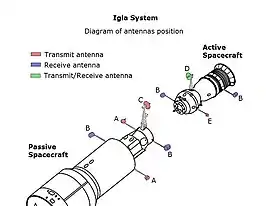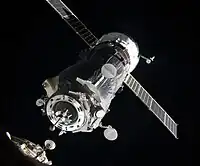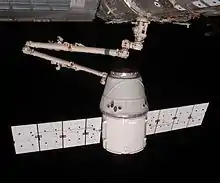Igla (spacecraft docking system)
The Igla (Russian: Игла, "Needle") docking system was a Soviet radio telemetry system for automated docking of Soyuz spacecraft.[1] The first prototypes were made in late 1965. On 30 October 1967, the first automated docking of Soyuz uncrewed spacecraft took place.[2][3]

Drawing of Soyuz with the Igla docking navigation system
Problems
- The Soyuz 15 mission was aborted when the system failed to dock to the Salyut 3, on 26 August 1974. There was no manual backup system.[4]
- Salyut 5, launched on June 22, 1976, was equipped with an improved radio system. On July 6, 1976, Soyuz 21 had problems undocking automatically, but was able to undock manually. Soyuz 23 failed to dock, ran out of fuel to manual dock, and returned to Earth.[5]
- The Igla docking system suffered an engine failure on Soyuz 33 on 10 April, 1979. After consideration by ground crews, the mission was aborted by firing the back up engines and initiating a ballistic reentry.[6]
Kurs
In 1986 Igla was succeeded by the Kurs docking system, first used on Soyuz TM-2.[7][8]
References
- Sven Grahn. "The IGLA radio system for rendez-vous and docking".
- "History". Archived from the original on April 24, 2008. Retrieved June 23, 2010.
- Soyuz and Progress Spacecraft, Historic Spacecraft
- Soyuz 15 Archived 2010-11-30 at the Wayback Machine, Encyclopedia Astronautica
- Spacecraft: manned: Almaz, RussianSpaceWeb.com
- Newkirk, Dennis (1990). Almanac of Soviet Manned Space Flight. Houston, Texas: Gulf Publishing Company. ISBN 0-87201-848-2.
- Soviet automated rendezvous and docking system overview. NASA Automated Rendezvous and Capture Review. Executive Summary p 34-35.
- "Soyuz TM-2".
External links
Wikisource has original text related to this article:
This article is issued from Wikipedia. The text is licensed under Creative Commons - Attribution - Sharealike. Additional terms may apply for the media files.

